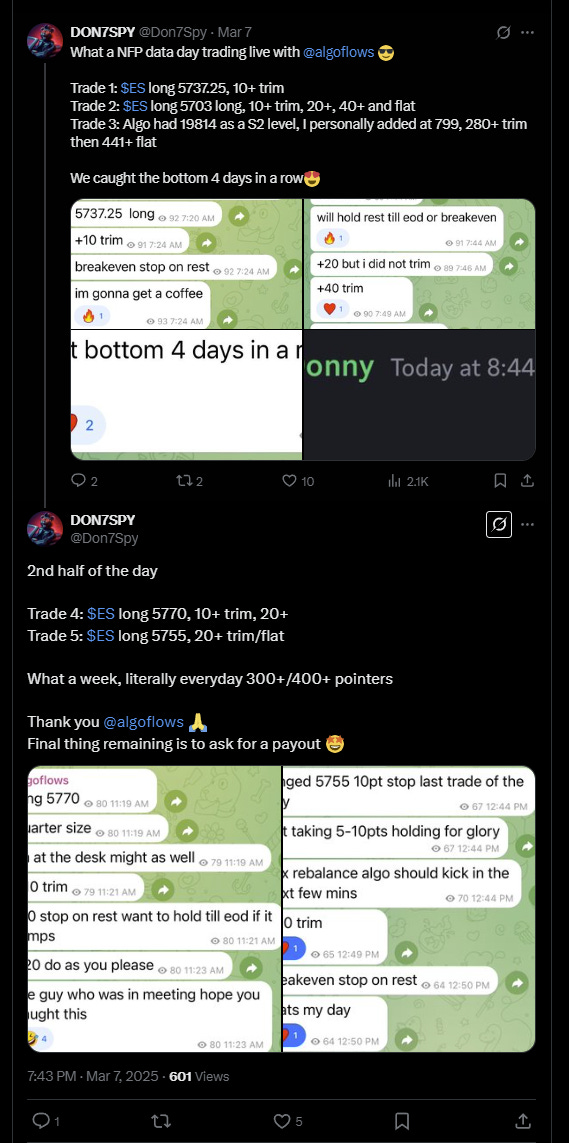Weekly Market Outlook 3/9/2025
Live by Vol, die by Vol.
Hello traders,
We had an extremely volatile week in the markets and it definitely was one of the most fruitful ones in terms of intra-day displacement on the indices.
Recap of select trades from last week:
Monday:
Tuesday:
Wednesday:
Thursday:
Lot of intraday scalps and then a bottom catch reverse
This was my favorite trade as it had an excellent statistical edge.
Friday:
Enough with tooting my own horn, back to what is in store for us this week.
Macroeconomic Landscape: Inflation Data Takes Center Stage
The Federal Reserve's policy trajectory remains the market's central fixation as traders recalibrate rate expectations amid persistent inflation pressures. Last week's comments from Fed Chair Jerome Powell reinforced the central bank's cautious stance toward premature easing, noting that while inflation has moderated from peak levels, the path to sustainable 2% remains uncertain.
"The disinflation process has proven more challenging than anticipated, particularly within the services sector," Powell remarked during his congressional testimony. "We require additional confirming evidence before initiating policy adjustments."1
This reluctance has dramatically reshaped market expectations, with CME FedWatch data showing March rate cut probabilities plummeting from 65% in January to just 3% currently. Markets have now priced approximately 75 basis points of easing for 2025, down from 150 basis points projected at year's start.
Inflation Metrics in Focus:
Wednesday’s Consumer Price Index (CPI) release represents the week's pivotal economic catalyst. Consensus expectations call for headline inflation of 0.3% month-over-month (2.9% year-over-year), with core inflation (excluding food and energy) projected at 0.26% month-over-month (3.4% year-over-year). Any upside surprise could further diminish rate cut expectations, potentially triggering equity weakness and yield increases.
The Cleveland Fed's inflation nowcast signals modest improvement, projecting March CPI at 2.47% year-over-year, down from February's 2.83%. However, this tentative progress remains insufficient to compel immediate Fed action, particularly as service inflation proves stubborn.
Thursday’s Producer Price Index (PPI) will provide additional inflation context, with economists anticipating a 0.2% month-over-month increase, reflecting easing but still elevated input cost pressures.
Geopolitical Tensions and Trade Policy
The Trump administration's evolving stance on tariffs has injected fresh uncertainty into global trade dynamics. Proposed measures include potential 25% universal tariffs on all imports and targeted 60% duties on Chinese goods, with particular focus on strategic sectors including semiconductors, electric vehicles, and renewable energy components.
These policy considerations have triggered reciprocal preparations abroad. The European Union has announced an €800 billion defense and infrastructure fund, partially aimed at insulating European manufacturers from potential U.S. tariffs. Similarly, Chinese officials have indicated readiness to accelerate domestic semiconductor development should export restrictions intensify.
Market participants should remain vigilant to headline risk in this domain, as unexpected policy announcements could trigger sector rotation and volatility spikes.
Bitcoin
Market Trends and Technicals
Bitcoin’s wild ride continues, with a 6.29% dip to $82,587.89 in the last 24 hours as of Sunday afternoon. Yet, the $85,000 level—a mix of psychological resistance and prior highs—looms as a formidable barrier.
Key Drivers
Inflation and Fed: Bitcoin’s “digital gold” narrative falters when equities tank. A hot CPI could sink it below $72,000; a dovish Fed signal might propel it past $85,000.
Regulation: Trump’s Bitcoin Reserve plan, using seized assets, has lost some luster. Fresh regulatory clarity—say, SEC approval of new crypto ETFs—could ignite bulls.
Risk Sentiment: Bitcoin’s 0.6 correlation with the S&P 500 means equity moves will drag it along. A tech rally lifts it; a sell-off sinks it.
Trade Ideas
Bullish (Breakout + Equity Rally):
Long: Buy at $83,000, target $90,000, stop at $80,000. Profit: $7,000 (~8.4%).
Bearish (CPI Shock + Risk-Off):
Short: Sell at $79,500, target $75,000, stop at $82,000. Profit: $4,500 (~5.6%).
Options: Buy $85,000 calls (expiry Mar 28) for upside, or $80,000 puts for downside protection.
Crude Oil (WTI)
Market Trends and Technicals
Crude Oil (WTI) at $67s is teetering on a knife’s edge, squeezed by bearish demand signals and bullish supply risks.
Levels: Support at $63.5, resistance at $72. Below $63.5 targets $58s ; above $72 eyes $75.
Chart Description: A choppy decline from $75 in February, hugging a flat 200-day SMA at $70, with a tight consolidation forming (technical analysis is mostly a scam however at some critical points it becomes a decent datapoint, more on this some other day).
Key Drivers
EIA Inventory (Mar 12): A projected 1.5-million-barrel build could push WTI below $63. A surprise drawdown (e.g., -1 million) might lift it to $67.
Geopolitics: U.S. sanctions on Iran and Russia cap supply, but no escalation keeps upside muted.
Demand: China’s sluggish recovery weighs on oil. A softer Fed outlook could boost growth forecasts, supporting prices.
Trade Ideas
Bullish (EIA Drawdown + Geopolitical Flare):
Long: Buy at $66, target $75, stop at $62.
Bearish (Inventory Build + Demand Woes):
Short: Sell at $63.50, target $58, stop at $67.
Hedging: Buy USO calls (strike $72) or puts (strike $68) based on EIA leanings.
ES and NQ
Technology stocks have experienced accelerated selling pressure, with the Nasdaq-100 demonstrating relative weakness compared to broader indices. Technical indicators(as if anyone cares about them) reflect deeply oversold conditions, potentially setting the stage for short-covering rallies amid continued fundamental challenges.
Semiconductor stocks warrant particular attention given their sensitivity to both consumer electronics demand and potential export restrictions. Recent Commerce Department guidance regarding advanced chip export limitations to China could pressure segment leaders during the coming sessions.
Considering this for ES , a “buyable dip” is at
Keep reading with a 7-day free trial
Subscribe to Algoflows Capital to keep reading this post and get 7 days of free access to the full post archives.












